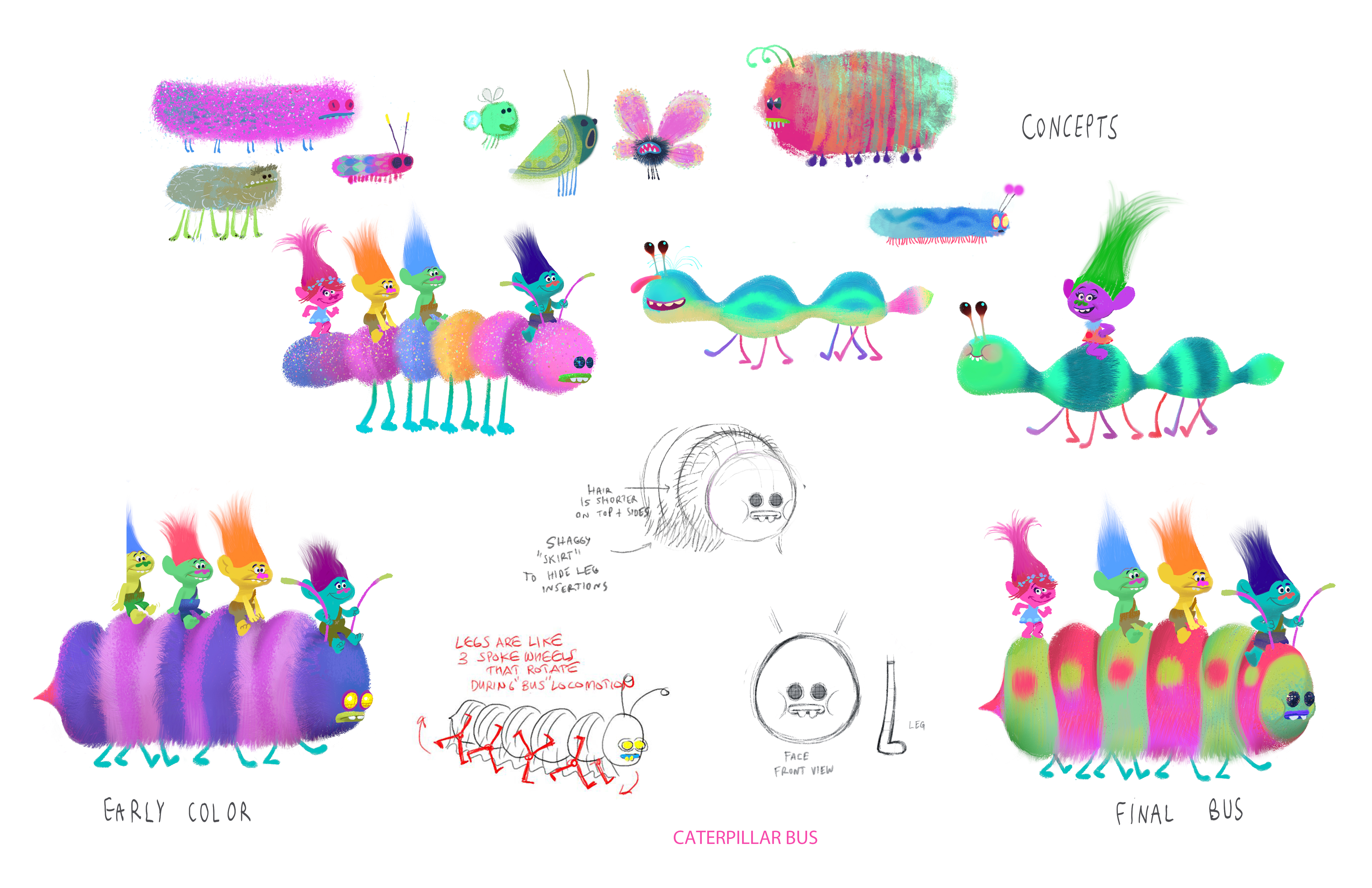profile / alumni / entertainment-design / illustration
February 09, 2017
Writer: Solvej Schou
From ArtCenter to Trolls, alum Kendal Cronkhite Can’t Stop the Feeling
Bring up ArtCenter to alumna Kendal Cronkhite (BFA 87 Illustration)—the Bay Area-based production designer of DreamWorks films including 2016’s Trolls, and a former consultant for virtual reality company Oculus VR's shuttered Oculus Story Studio—and she feels a wallop of emotion.
“It makes me cry, actually, if I think about it,” she said recently, at her warmly lit Glendale DreamWorks office. “It was a highlight of my life, honestly, and they cared so much about grounding us in strong skills, in building up your eyes, your hand. By my seventh and eighth term, I was really going for it, which I think you see happen a lot with ArtCenter students. I felt like my best creative self, and I felt really understood.”
The very nature of happiness, of understanding and creativity, is explored throughout Trolls, out on Blu-ray this week. Based on the round-bellied Troll dolls created in 1959 by Danish toymaker Thomas Dam, the film’s Trolls are brightly hued forest creatures whose Day-Glo hair surges sky-ward. They’re prone to singing, dancing and exuberant hugging, and a group of them are captured by the huge gray carnivorous Bergens, who deep down want to be happy too.
Responsible for designing the look of the film, Cronkhite researched ‘70s Scandinavian design, forests in Denmark and Norway, and Nordic mythology for inspiration. Cronkhite grew up playing with Barbies, but had a friend in her Vancouver, Canada neighborhood who loved Troll dolls.

It became very important in the script that the Trolls’ hair was a source of magic for them. Then their shape, that they were pudgy, stubby-shaped things with no long, elegant lines.”
Kendal Cronkhite

“I always say the Trolls are like the hippies of the ‘70s and the Bergens are like the suburbanites of the ’70s,” said Cronkhite, sitting next to a board with colorful clumps and strands of yarn resembling Troll doll hair.
“I tried to crack the character code of the doll,” she added. “It became very important in the script that the Trolls’ hair was a source of magic for them. Then their shape, that they were pudgy, stubby-shaped things with no long, elegant lines. For a long time, they were going to be naked! It didn’t end up that way. You go through so many ideas.”
Ideas, since childhood, have always come easily to Cronkhite.
She relished drawing comics as a kid, and later created ceramics and fabric art. By the time she came to ArtCenter in her early 20s, she had developed a fondness for edgy musicians including David Bowie and The Clash, plus artists such as Picasso. She respected not only Picasso’s prolific expressiveness, but how strong his foundation was as a painter. She found that foundation at ArtCenter.
“I love Picasso because of his journey as an artist—where he started and where he ended up,” she said.

After working in editorial illustration in Canada and New York City after graduating, Cronkhite moved back to California. There, wetting her feet in animation, she was offered assistant art director work on none other than Tim Burton’s 1993 darkly musical stop-motion classic The Nightmare Before Christmas. She was already a Burton fan.
Nightmare led later to Cronkhite joining DreamWorks as art director on its first-ever studio film, Antz. Antz segued into Cronkhite being a production designer on irreverently funny, animal-filled Madagascar (2005), Madagascar: Escape 2 Africa (2008) and Madagascar 3: Europe's Most Wanted (2012).
Collaboration and teamwork on films promote flexibility, she said.
“As an illustrator, I was working by myself a lot in my room, and that’s fine, but it’s also hard,” she said. “What’s great about collaborating on a film is that you can still have your voice—and especially if you get on a project that you connect with artistically—but then you grow faster as an artist because of constant feedback, seeing what other people are doing and stretching yourself to meet another artistic vision.”

Joining newly closed Oculus Story Studio as a production design consultant, Cronkhite saw her professional world expand and stretch even more. She worked on the Emmy-winning short Henry, about a toothy and bug-eyed lovable hedgehog, and was helping to develop a secretive project that encompassed “huge steps forward in VR,” said Cronkhite.
When the company first contacted her in 2015 with the simple subject line “Oculus + Kendal,” it didn’t take long for her to be interested. She then strapped on an Oculus Rift headset, and jumped down the rabbit hole of Oculus’ debut short film Lost—her first time experiencing VR.
“It was a forest at night, and there was this huge robot—stories high—that you’re with. It was so magical, like being inside my dreams,” she said. “You’re both present in that world, and you’re also the camera. Every experience isn’t the same length. You can go in and take much longer for the story than I would take.”
She compares the innovative medium to immersive theater, with attributes from animation, film and games. VR has emerged as yet another way to tell stories and create worlds, she said.
“It’s new, it’s here and it will be really exciting to see what happens,” said Cronkhite. “My advice for anyone looking for work in VR or animation is to bring something exciting and fresh that can inspire the look for a project. That’s going to be your ‘in.’ If you’re trying to get noticed, you need to have something uniquely special, but you also want to have those foundation skills underneath.”


